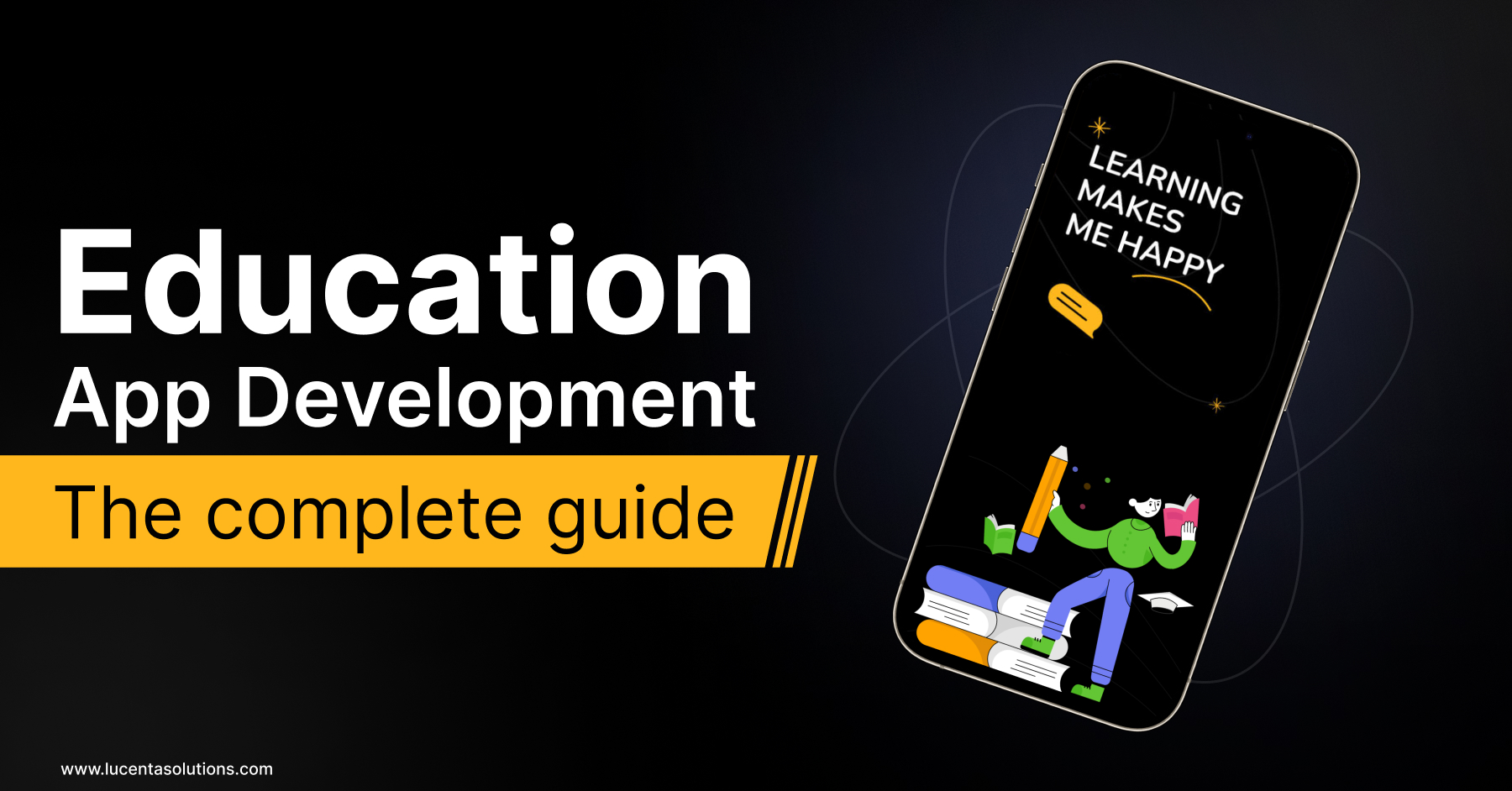Educational App Development – The Complete Guide
We live in the e-learning age where students and working professionals use educational mobile apps to pursue courses, irrespective of the location. The educational app market is rising thanks to the growing demand for ed-tech solutions. According to one report, the e-learning app market is ranked among the top sectors with many mobile-friendly goods. For instance, the revenue earned by educational apps increased 7.2% from 2021 to $7 billion in 2022.
There are thousands of educational applications having downloads in millions. With 98 million downloads, Duolingo’s language-learning program became the most downloaded learning and educational app worldwide. Many top educational mobile apps have the best UI/UX and are downloaded by millions.
But what makes these educational mobile apps downloadable and usable? What goes behind in developing these apps? We have created a detailed guide for you if you have mobile app ideas and want to break into this ever-growing field. This blog provides a complete guide on educational app development, benefits, and choosing the best one.
Short Market Survey about Educational Mobile Apps
Before the digital age, all classes were structured in person using tangible books. However, things changed with mobile apps and when online learning came into play. The demand further shot up during the post-covid era. According to one survey, the ed-tech industry can reach 11.6 billion USD by 2025. Below are a couple of essential surveys you should know:
- The education app may grow at an 8.9% CAGR pace from 2023 to 2030.
- 63% of US students prefer educational apps to study or seek learning resources.
Benefits of Educational App Development
Thanks to smartphones, students can now easily access information anytime and anywhere. These are just a handful of mobile applications’ numerous services, including learning, assessments, quizzes, and more. Not only has this increased enjoyment, but it has also improved the student’s overall academic performance. Although the educational application development process is quite complex, it has good benefits. Some of these are-
Easy to Learn
E-learning has made learning more manageable than before. Students can access the content from anywhere at any time. Even after leaving the school, students can continue to access materials for an extended period. Teachers can engage with their students virtually through assessments, online chats, and other resources like educational movies.
If students can work independently and at their own pace, they will be more involved in learning.
Advanced Learning Process
One of the main advantages of educational apps for students is that they focus directly on their psychology, which helps them understand the content and see it differently. The app provides kids with challenging puzzles, brainteasers, and other educational tasks to aid in their comprehension of concepts. The majority of pupils favor teaching using audiovisual means.
Since kids receive this fresh learning environment without working too hard, so they are enthusiastic and ready to learn.
Diversified Content
There is no denying that there is an abundance of content available online. This also holds for the options available to users regarding choosing their favored platforms. Students using learning apps can easily access the content anytime because it is available in a vast range. They are allowed to make their own choices and have the power to convince a substantial number of people from all over the world to visit it for various issues or themes.
24/7 Available
Students can come up with doubts anytime, and making solutions available 24/7 is essential. As a result, learning with mobile apps does not need a rigid timetable; instead, students can study whenever and wherever they choose.
Furthermore, students cannot focus for extended periods and are frequently distracted, so time-bound training is useless. Educational applications are the best since they are available to students around the clock and can be used whenever needed.
Easy Communication
Parents have been complaining about how little time their children spend with them for a very long time. Researchers have found that mobile educational technologies increase children’s engagement and may enhance their communication with parents. Parents will get all the updates from the institute on the app. Parents and kids can engage in activities and study together at a table. Parents can also assist young children to learn quickly.
On the other hand, it is challenging for parents and teachers to stay in touch through face-to-face interactions because of their hectic schedules. Thanks to these apps, there is no bridge, and they can easily interact.
Step-by-Step Guide on Educational App Development
Since institutes are ready to invest in apps to offer online education, the demand for education app development companies in USA has increased. These companies work on the latest tools and progress in the project step-by-step ensuring the final product is of top quality. To build an educational app, mobile app developers need to follow the below-mentioned steps-
- Ideation
- Research
- Design
- Development
- Testing
- Deployment
There are a variety of actions at each step that are essentially the same for all projects; however, there are some differences in educational mobile app development. Educational app development services work through different stages while creating a product. Let us guide you through the main stages of developing an academic application.
- Ideation
This is the very first step of educational app development. At this stage, the idea for the academic application is developed and discussed with the vendor. A vendor initiates product development verifies the idea’s feasibility, and works on the technical documents and essential features based on the preliminary requirements gathered.
To help stakeholders understand better, developers create mock-ups of the application interface. A thorough understanding is essential to prevent issues during the later development stage of the education app. The developer will include different mobile app ideas as per the client’s requirement.
- Research
Once the concept is ready, it’s time to study the competitors and market. This will assist you in identifying market gaps, improving the idea of your app, and comprehending the present state of educational app development.
- Design
For an educational app to be user-friendly and entertaining, it is essential to have the right design. You must create the app’s visual components, user interface (UI), and user experience (UX). This phase includes wireframing, prototyping, and style guide creation.
- Development
Once the design is ready, the development process begins. Coding and programming are typically involved at this stage, integrating features like social learning, gamification, and assessment tools. This process takes the maximum time before stepping into further action.
- Testing
Testing is an essential part of educational mobile app development. Once the app is created, it must be extensively tested to ensure there are no bugs and that it works as planned. The main aim is to provide high-quality assurance for the app user.
- Deployment
Once everything is done, the education app development company will release the same on the app store or internet marketplace after it has been verified and tested. Creating an app store listing, search engine optimizing your app, and developing a marketing plan to promote your app are all part of this step.
Different Types of Educational App Development
When you plan to develop educational mobile apps, you need to work on your target audience. There are different types of mobile app ideas in the market. Some of these are-
- Education App for Kids
Kids get quickly drawn towards apps, and parents are concerned about their early development and attempt to capitalize on their pastime. These could be the most varied uses—for acquiring skills in science, writing, reading, or talent development. An education app is designed to help kids learn new things and help parents not worry about wrong learning or distractions.
- Educational Gaming Apps
Developing an educational app with built-in gaming is an additional intriguing concept. Students can use these applications to play educational games and take educational quizzes. These games assist students in learning and performance evaluation through a single platform. Additionally, the children can play games based on their age group, skill level, and category.
- Classroom Apps
There are two kinds of applications available for teachers and students. The first one is utilized in class, provides teachers with instructional material, and aids in structuring instruction and the learning process. The second kind is used for remote learning and is an application that runs on the cloud. It provides choices for parent-teacher communication and knowledge acquisition and centralizes all instructional resources in one location.
A mobile app development company would work on creating these classroom apps per the institute’s requirements.
- Language Learning Mobile App
These apps have benefits beyond language learning, such as expanding students’ vocabulary. A finely developed educational application helps with quick lessons and covers a particular language.
By including incentive points for finishing each level, you may further enhance the dynamic nature of learning. The ability to track progress is made possible by an extra AI-based function for learners. Thanks to this function, they could assess their advantages and disadvantages.
How can Lucenta Solutions help with Educational App Development?
Since we now know the benefits and steps of developing educational mobile apps, the question is, which is the best education app development company? Lucenta Solutions, one of the leading education app development companies in USA has worked with multiple clients in developing such apps.
Backed by a team of professional mobile app developers, Lucenta Solutions engineers mobile apps usable for students, teachers, and parents. If you have an idea for developing an education application, connect with a professional mobile app development company that uses modern tools for quality products.
FAQ
1) How much does it cost to build an educational app?
Ans: Estimating the true cost of developing the educational app is challenging. The price also varies depending on the platform you’re using—Hybrid, Native, iOS, or Android. However, the overall cost is around $25,000 to $30,000 or more.
2) How long does it take to develop an educational app?
Ans: It entirely depends on how complex the app is. A basic education app would take 3-4 months, but a complex one would take more.
3) How many types of educational apps are there?
Ans: There are different educational apps including Language learning apps, flashcard applications, Special learning applications, etc.




